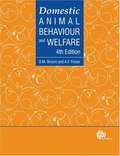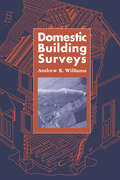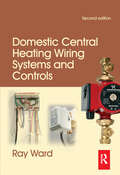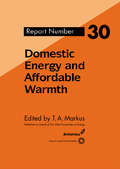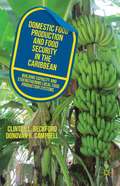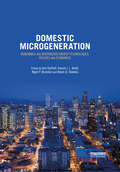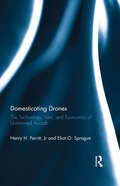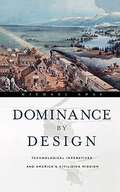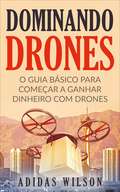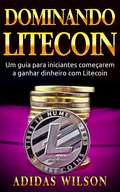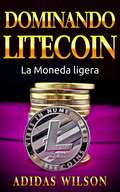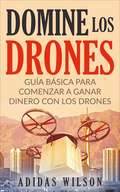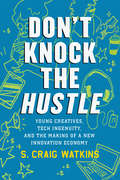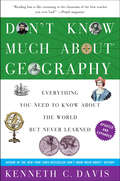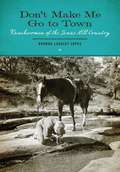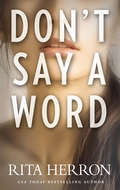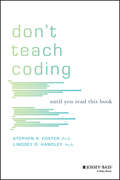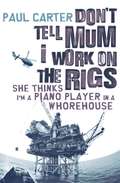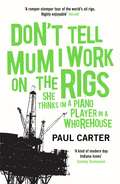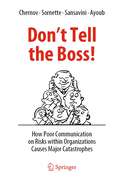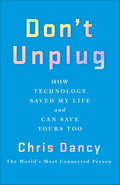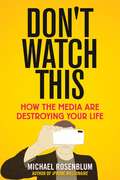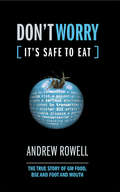- Table View
- List View
Domestic Animal Behaviour and Welfare, 4th edition
by Donald Broom Andrew FraserBehaviour is a significant indicator of health in animals and understanding behaviour is the key to good management. Animal behaviour and animal welfare science are fast becoming core topics in the curriclua of agriculture and veterinary students. The eagerly awaited fourth edition of Farm Animal Behaviour and Welfare builds on the coverage of the previous edition, fully updating it to take into account developments over the last 10 years. This new edition covers companion animals as well as farm animal species including farmed fish. It is an indispensible textbook covering the major and growing areas in agricultural and veterinary science and practice.
Domestic Animals and Leisure: Rights, Welfare, And Wellbeing (Leisure Studies in a Global Era)
by Neil CarrThis volume offers both an insight into the current state of research on domestic animals in leisure and a lens through which to begin to chart the future of research in this field. All of the contributions to the collection are underpinned by ongoing debates about human-animal relationships and the rights and welfare of the latter.
Domestic Building Surveys
by Andrew WilliamsThis is a practical guide showing how to undertake a domestic building survey. The text describes the practical aspects of surveying with a full description of the author's own experience, at the same time drawing out the important principles involved.
Domestic Central Heating Wiring Systems and Controls (2nd Edition)
by Raymond WardThis unique A-Z guide to central heating wiring systems provides a comprehensive reference manual for hundreds of items of heating and control equipment, making it an indispensable handbook for electricians and installers across the country. The book provides comprehensive coverage of wiring and technical specifications, and now includes increased coverage of combination boilers, recently developed control features and SEDBUK (Seasonal Efficiency of Domestic Boilers in the UK) boilers ratings, where known.In addition to providing concise details of nearly 500 different boilers fuelled by electric, gas, oil and solid fuel, and over 400 programmers and time switches, this invaluable resource also features numerous easy-to-understand wiring diagrams with notes on all definitive systems. Brief component descriptions are provided, along with updated contact and website details for most major manufacturers.Ray Ward has spent over 20 years as a specialist in the field of wiring domestic central heating systems and the knowledge he has gained from hands-on experience and staff training is now brought together in this comprehensive handbook.
Domestic Energy and Affordable Warmth (The\watt Committee On Energy Ser. #Vol. 30)
by T. MarkusThis report arises out of the Working Group set up by The Watt Committee on Energy to examine the issues relating to domestic use and affordable warmth. With contributions from both academia and industry, and also calling on the expertise of others deeply involved in the subject, this book provides the reader with an authoritative coverage of providing affordable warmth to those living on low means or in inadequate premises.
Domestic Food Production and Food Security in the Caribbean
by Clinton L. Beckford Donovan R. CampbellWith the exception of Haiti, the sensationalized issues of hunger reported in certain parts of the developing world are largely unknown in the Caribbean. Despite this, there are growing concerns about the state of food security in the region, as declining domestic production and increased dependence on imported food create vulnerability. This study examines some of the contemporary issues impacting food production and food and nutrition security in the CARICOM region of the Caribbean. The authors focus on enhancing domestic food production as the most appropriate way to improve food security and discuss strategies for building capacity in local food production systems. The book is the product of over ten years of research by the authors. It will be of interest to scholars and students of Caribbean geography, cultural geography, food and agricultural geography, and food security.
Domestic Microgeneration: Renewable and Distributed Energy Technologies, Policies and Economics
by Iain Staffell Daniel J.L. Brett Nigel P. Brandon Adam D. HawkesMicrogeneration – producing energy for the home, in the home – is a substantial improvement over the current centralised and detached energy model employed the world over. Domestic Microgeneration is the first in-depth reference work for this exciting and emerging field of energy generation. It provides detailed reviews of ten state-of-the-art technologies: including solar PV and thermal, micro-CHP and heat pumps; and considers them within the wider context of the home in which they are installed and the way that they are operated. Alongside the many successes, this book highlights the common pitfalls that beset the industry. It offers best-practice guidance on how they can be avoided by considering the complex linkages between technology, user, installer and government. This interdisciplinary work draws together the social, economic, political and environmental aspects of this very diverse energy ‘genre’ into a single must-have reference for academics and students of sustainability and energy related subjects, industry professionals, policy makers and the growing number of energy-literate householders who are looking for ways to minimise their environmental footprint and their energy bills with microgeneration.
Domesticating Drones: The Technology, Law, and Economics of Unmanned Aircraft
by Henry H Perritt, Jr. Eliot O SpragueThe public debate over civilian use of drones is intensifying. Variously called "unmanned aircraft systems", "unmanned aerial vehicles", "remotely piloted aircraft", or simply "drones", they are available for purchase by anyone for a few hundred to a few thousand dollars. They have strikingly useful capabilities. They can carry high-definition video cameras, infrared imaging equipment, sensors for aerial surveying and mapping. They can stream their video in real time. They have GPS, inertial guidance, magnetic compasses, altimeters, and sonic ground sensors that permit them to fly a preprogrammed flightplan, take off and land autonomously, hover and orbit autonomously with the flick of a switch on the DRone Operator’s ("DROPs") console. The benefits they can confer on law enforcement, journalism, land-use planning, real estate sales, critical infrastructure protection and environmental preservation activities are obvious. However, their proliferation in response to these demands will present substantial risks to aviation safety. How to ensure the safety of drone operations perplexes aviation regulators around the world. They are inexpensive consumer products, unsuited for traditional requirements for manned aircraft costing hundreds of thousands or millions of dollars and flown only by licensed pilots who have dedicated significant parts of their lives and their wealth to obtaining licenses. Regulatory agencies in Europe and Asia are ahead of US regulators in creating spaces for commercial use. Over the next several years, legal requirements must be crystallized, existing operators of helicopter and airplanes must refine their policy positions and their business plans to take the new technologies into account, and all businesses from the smallest entrepreneur to large conglomerates must decide whether and how to use them. Domesticating Drones offers rigorous engineering, economics, legal and policy theory and doctrine on this important and far-reaching development within aviation.
Dominance By Design: Technological Imperatives And America's Civilizing Mission
by Michael AdasLong before the United States became a major force in global affairs, Americans believed in their superiority over others due to their inventiveness, productivity, and economic and social well-being. U. S. expansionists assumed a mandate to "civilize" non-Western peoples by demanding submission to American technological prowess and design. As an integral part of America's national identity and sense of itself in the world, this civilizing mission provided the rationale to displace the Indians from much of our continent, to build an island empire in the Pacific and Caribbean, and to promote unilateral-at times military-interventionism throughout Asia. In our age of "smart bombs" and mobile warfare, technological aptitude remains preeminent in validating America's global mission. Michael Adas brilliantly pursues the history of this mission through America's foreign relations over nearly four centuries from North America to the Philippines, Vietnam, and the Persian Gulf. The belief that it is our right and destiny to remake foreign societies in our image has endured from the early decades of colonization to our current crusade to implant American-style democracy in the Muslim Middle East. Dominance by Design explores the critical ways in which technological superiority has undergirded the U. S. 's policies of unilateralism, preemption, and interventionism in foreign affairs and raised us from an impoverished frontier nation to a global power. Challenging the long-held assumptions and imperatives that sustain the civilizing mission, Adas gives us an essential guide to America's past and present role in the world as well as cautionary lessons for the future.
Dominando Drones: O Guia Básico para Começar a Ganhar Dinheiro com Drones
by Adidas WilsonEstas informações são a razão pela qual escrevi este livro. De acordo com minhas pesquisas, o ano de 2015 será marcante para os drones. Agora é a hora de empreender para ganhar dinheiro com estes dispositivos. Drones comerciais e seus serviços devem se tornar uma indústria multibilionária na próxima década, de acordo com um novo relatório da empresa de inteligência de mercado Tractica. O relatório diz que, em 2017, a receita de drones deve totalizar US$ 792 milhões - principalmente com vendas de hardware. Até 2025, a Tractica prevê que o mercado aumentará para US$ 12,6 bilhões, com dois terços da receita proveniente de serviços baseados em drones e não de hardware. "Várias indústrias importantes estão vendo futuro na utilização de drones para uso comercial", diz Manoj Sahi, analista de pesquisa da Tractica. Ele citou a mídia, o setor imobiliário e a assistência a desastres como apenas alguns dos setores que poderiam usar serviços habilitados para drones. O relatório afirma que os avanços tecnológicos, as economias de escala, os aplicativos baseados em nuvem e o desejo de romper com o mercado contribuirão para o sucesso comercial dos drones nos próximos anos.
Dominando Litecoin: Um guia para iniciantes começarem a ganhar dinheiro com Litecoin
by Adidas WilsonLitecoin foi criado como uma alternativa ao Bitcoin para compensar as suas falhas notáveis, e foi desenvolvido para ser “leve” e mais abundante que o Bitcoin. Litecoin também possui quase zero custo de pagamento e facilita as transações, realizadas aproximadamente quatro vezes mais rápido que o Bitcoin. Sumário Introdução ao Litecoin 1. Carteiras de criptomoedas 2. Como comprar Litecoin 3. Minerando Litecoin e outras altcoins 4. O melhor investimento: Bitcoin ou Litecoin 5. Carteiras Litecoin 6. Bitcoin x Litecoin 7. Invista em Litecoin 8. A influência do SegWit 9. Usuários da Coinbase 10. A segunda maior moeda 11. Trabalhando com bitcoins 12. O objetivo da blockchain 13.Feathercoin 14. ICO 15. Entendendo a criptoeconomia 16. Criptomoeda: O guia definitivo Referências
Dominando Litecon. La Moneda ligera.
by Jose Saul Agis Garcia Adidas WilsonNuestro autor es un empresario que siempre ha buscado resalatar la importancia de la criptomoneda a nivel global, tomando en consideración las necesidades de las personas que de igual manera se interesan en nuevos recursos intercambiarios. Con esta guía nos daremos cuenta de la importancia de conocer a las nuevas monedasm, en especial, las criptomonedas.
Dominar Apple TV 4K: Guía de usuario definitiva para Apple TV con Siri
by Adidas WilsonCuando usted escucha hablar de Apple TV inmediatamente piensa que lo que usted está comprando es una TV Real. Pero no es el caso. La Apple TV es un dispositivo que usted utilizará realmente para que le transmita algo y que es parecido al Fire de Amazon o al Roku. Es una pequeña caja negra de alrededor de una pulgada y media de alto, y sólo un poco menos que cuatro pulgadas, que funciona en una plataforma muy similar al iPad y los populares iPhones. Usted puede descargar una lista de apps y además juegos más allá de la transmisión standard de video que usted podría obtener desde Hulu, Netflix y Amazon por solamente nombrar algunos. La Apple TV ha sido centrada en varias apps, y todavía es capaz de transmitir múltiples shows de TV, y películas directamente en su HDTV, pero esto es solamente la punta del iceberg de las características con las que esta caja ha sido fabricada. La caja le permite a usted ver y transmitir podcasts, jugar a su juego favorito, transmitir su lista de ejercicios, y mucho más. Pero lo que es importante notar, para disfrutar de todos estos beneficios con los que esta caja está lista para proveerle es que todo dependerá de las apps que usted haya instalado. Algunas de las apps que usted utilizará son gratis, y algunas le costarán. Piénselo de esta manera; la Apple TV es capaz de transformar a su TV en una Smart TV. Incluso puede rentar sus películas favoritas o solamente transmitir su colección desde su cuenta de iTunes. Además puede transmitir shows de películas desde apps como Hulu Plus o Netflix; transmitir su música desde las apps de Pandora o Apple Music. Quiero decir que la lista es interminable en aquello que la Apple TV puede hacer por usted. La Apple TV 4K ha sido diseñada con algunos de los procesadores más rápidos que usted pueda encontrar, los mismos que alimentan al iPad Pro. La caja de Apple TV ha sido hecho para ser tan poderosa como la mayoría de las laptops que utilizamos. Además posee un procesador g
Domine Los Drones, Guía Básica para Comenzar a Ganar Dinero con los Drones
by Adidas WilsonSe espera que los drones comerciales y sus servicios se conviertan en una industria multibillonaria en la próxima década, de acuerdo con un nuevo informe de la firma de inteligencia de mercados Tractica. El informe indica que en 2017 los ingresos generados por los drones deben llegar a aproximadamente US$792 millones, principalmente por ventas de equipos. Para 2025, Tractica predice que este mercado crecerá hasta alcanzar US$12.600 millones, donde las dos terceras partes de estos ingresos vendrán más de servicios prestados por drones que de ventas de equipos. “Hay varias industrias importantes que están viendo fuertes propuestas de valor en la utilización de drones para uso comercial” dice Manoj Sahi, analista de investigación de Tractica. El nombra a los medios, los bienes raíces y la asistencia a casos de desastres, como solo algunas de las industrias que podrían usar servicios prestados por drones. El informe dice que los avances en la tecnología, las economías de escala, las aplicaciones basadas en la nube y el deseo de trastornar el mercado contribuirán al éxito comercial de los drones en los próximos años.
Don't Knock the Hustle: Young Creatives, Tech Ingenuity, and the Making of a New Innovation Economy
by Craig S. WatkinsHow millennials are changing our ideas about work, the "gig economy", social mobility, opportunity and technologyMillennials are coming of age at a time when work is temporary, underpaid, incommensurate with their education, or downright unsatisfying. Despite these challenges, media scholar S. Craig Watkins argues that this moment of precarity is rife with opportunities for innovation, and that millennials are leading the charge at turning that into an inventive and surprisingly sustainable future.At the intersection of ethnography, sociology, social history and pop culture, Don't Knock the Hustle is one of the first attempts to document how millennials are building a creative, entrepreneurial, and civically engaged innovation economy. Here, we meet people like Prince Harvey, a hip hop artist who recorded his album entirely on an Apple showroom laptop; screenwriter, producer and actor Issa Rae, who first used YouTube and Kickstarter to develop the web series that became her hit HBO show, Insecure; and start-up companies like Qeyno Group in San Francisco and Juegos Rancheros in Austin, TX that help make tech more accessible to people of color. Don't Knock the Hustle offers a timely analysis of the sheer ingenuity and persistence of young people who cobble together the resources they need to pursue the lives and careers they want.Drawing on over ten years of interviews and data, Watkins reveals the radical ways in which our society is expanding who we think of as innovators, what qualifies as innovation, and the spread of wealth beyond traditional corridors of powerful tech companies, venture capitalism, and well-endowed universities. Forward-thinking and dynamic, Don't Knock the Hustle shows the diversity and complexity of a generation on the rise.
Don't Know Much About Geography: Everything You Need to Know About the World but Never Learned (The Don't Know Much About Series)
by Kenneth C. DavisAn “entertaining [and] eminently readable” exploration of our home planet from the New York Times–bestselling author of Don’t Know Much About History(Publishers Weekly).Geography is much more than naming countries on a map or memorizing state capitals. It’s the hub from which other disciplines radiate: meteorology, ecology, geology, oceanography, demographics, cartography, agricultural studies, economics, and political science. Yet many of us don’t know much about it. This fun and fascinating guide can change that!In addition to presenting plenty of geographical trivia to impress your friends, Kenneth C. Davis explores 21st-century topics of global concern, including the role of the Internet and technology in transforming the lives of people around the world, how so-called developing nations develop, sustainability, and debates over climate change and evolutionary science. This completely revised and updated version of Don't Know Much About Geography is an illuminating grand tour of planet Earth.“Reading [Kenneth C. Davis] is like returning to the classroom of the best teacher you ever had.” —PeopleA School Library Journal “Must-Read”
Don't Make Me Go to Town
by Rhonda Lashley LopezMany people dream of "someday buying a small quaint place in the country, to own two cows and watch the birds," in the words of Texas ranchwoman Amanda Spenrath Geistweidt. But only a few are cut out for the unrelenting work that makes a family ranching operation successful. Don't Make Me Go to Town presents an eloquent photo-documentary of eight women who have chosen to make ranching in the Texas Hill Country their way of life. Ranging from young mothers to elderly grandmothers, these women offer vivid accounts of raising livestock in a rugged land, cut off from amenities and amusements that most people take for granted, and loving the hard lives they've chosen. Rhonda Lashley Lopez began making photographic portraits of Texas Hill Country ranchwomen in 1993 and has followed their lives through the intervening years. She presents their stories through her images and the women's own words, listening in as the ranchwomen describe the pleasures and difficulties of raising sheep, Angora goats, and cattle on the Edwards Plateau west of Austin and north of San Antonio. Their stories record the struggles that all ranchers face-vagaries of weather and livestock markets, among them-as well as the extra challenges of being women raising families and keeping things going on the home front while also riding the range. Yet, to a woman, they all passionately embrace family ranching as a way of life and describe their efforts to pass it on to future generations.
Don't Say a Word
by Rita HerronGroomed by a covert group of elite killers, Damon left the secretsociety to join the FBI after a mission went brutally wrong andan innocent woman died.When his brother is arrested for murder, Damon investigates andfinds a "Jane Doe" who holds the key to the case, along witha darker terror-one that threatens to expose Damon's deadlysecrets and destroy them all. Despite the danger, he's drawn to the nameless beauty, igniting apassion that burns hot between them. But with a madman out tosilence her forever, Damon knows he must deny their love. Andto stop the man responsible, he must return to the one placehe has desperately tried to leave behind-the dark shadows ofa killer's mind....
Don't Teach Coding: Until You Read This Book
by Lindsey D. Handley Stephen R. FosterThe definitive resource for understanding what coding is, designed for educators and parents Even though the vast majority of teachers, parents, and students understand the importance of computer science in the 21st century, many struggle to find appropriate educational resources. Don't Teach Coding: Until You Read This Book fills a gap in current knowledge by explaining exactly what coding is and addressing why and how to teach the subject. Providing a historically grounded, philosophically sensitive description of computer coding, this book helps readers understand the best practices for teaching computer science to their students and their children. The authors, experts in teaching computer sciences to students of all ages, offer practical insights on whether coding is a field for everyone, as opposed to a field reserved for specialists. This innovative book provides an overview of recent scientific research on how the brain learns coding, and features practical exercises that strengthen coding skills. Clear, straightforward chapters discuss a broad range of questions using principles of computer science, such as why we should teach students to code and is coding a science, engineering, technology, mathematics, or language? Helping readers understand the principles and issues of coding education, this book: Helps those with no previous background in computer science education understand the questions and debates within the field Explores the history of computer science education and its influence on the present Views teaching practices through a computational lens Addresses why many schools fail to teach computer science adequately Explains contemporary issues in computer science such as the language wars and trends that equate coding with essential life skills like reading and writing Don't Teach Coding: Until You Read This Book is a valuable resource for K-12 educators in computer science education and parents wishing to understand the field to help chart their children’s education path.
Don't Tell Mom I Work on the Rigs: She Thinks I'm a Piano Player in a Whorehouse
by Paul CarterSince age 18, Paul Carter has worked on oil rigs in locations as far flung as the Middle East, Columbia, the North Sea, Borneo, Tunisia, Sumatra, Vietnam, Nigeria, Russia, and many others - and he's survived (so far!) to tell stories from the edge of civilization (places, as it happens, upon which most of our lives rely). Carter has been shot at, hijacked and held hostage, almost died of dysentery in Asia and toothache in Russia, watched a Texan lose his mind in the jungles of Asia, lost a lot of money backing a scorpion against a mouse in a fight to the death, and served cocktails by an orangutan on an ocean freighter. Taking postings in some of the world's wildest and most remote regions - not to mention some of the roughest rigs on the planet - Carter has worked and gotten into trouble with some of the maddest, baddest and strangest people you could ever hope not to meet.
Don't Tell Mum I Work on the Rigs: (She Thinks I'm a Piano Player in a Whorehouse)
by Paul CarterA take-no-prisoners approach to life has seen Paul Carter heading to some of the world's most remote, wild and dangerous places as a contractor in the oil business. Amazingly, he's survived (so far) to tell these stories from the edge of civilization. He has been shot at, hijacked and held hostage; almost died of dysentery in Asia and toothache in Russia; watched a Texan lose his mind in the jungles of Asia; lost a lot of money backing a scorpion against a mouse in a fight to the death, and been served cocktails by an orangutan on an ocean freighter. And that's just his day job. Taking postings in some of the world's wildest and most remote regions, not to mention some of the roughest rigs on the planet, Paul has worked, got into trouble, and been given serious talkings to, in locations as far-flung as the North Sea, Middle East, Borneo and Tunisia, as exotic as Sumatra, Vietnam and Thailand, and as flat-out dangerous as Columbia, Nigeria and Russia, with some of the maddest, baddest and strangest people you could ever hope not to meet.
Don't Tell the Boss!: How Poor Communication on Risks within Organizations Causes Major Catastrophes
by Didier Sornette Dmitry Chernov Ali Ayoub Giovanni SansaviniThe book reviews existing research on the challenges of voice and silence in organizations. After a major disaster, when investigators are piecing together the story of what happened, a striking fact often emerges: before disaster struck, some people in the organization involved were aware of dangerous conditions that had the potential to escalate to a critical level. But for a variety of reasons, this crucial information did not reach decision-makers. So, the organization moved ever closer to catastrophe, effectively unaware of the possible threat—despite the fact that some of its employees could see it coming.What is the problem with communication about risk in an organization, and why does this problem exist? What stops people in organizations or project teams from freely reporting and discussing critical risks? This book seeks to answer these questions, starting from a deep analysis of 20 disasters where the concealment of risks played a major part.These case studies are drawn from around the world and span a range of industries: civil nuclear power, coal, oil and gas production, hydropower energy, metals and mining, space exploration, transport, finance, retail manufacturing and even the response of governments to wars, famines and epidemics.Together, case studies give an insight into why people hesitate to report risks—and even when they do, why their superiors often prefer to ignore the news.This helps to explain more generally why people dread passing on bad news to others—and why in the workplace they prefer to keep quiet about unpleasant facts or potential risks when they are talking to superiors and colleagues.The discussion section of the book includes important examples of concealment within the Chinese state hierarchy as well as by leading epidemiologists and governments in the West during the novel coronavirus outbreak in Wuhan in 2019-2020. The full picture of the very early stage of the COVID-19 pandemic remains unclear, and further research is obviously needed to better understand what motivated some municipal, provincial and national officials in China as well as Western counterparts to obfuscate facts in their internal communications about many issues associated with the outbreak.
Don't Unplug: How Technology Saved My Life and Can Save Yours Too
by Chris DancyChris Dancy, the world's most connected person, inspires readers with practical advice to live a happier and healthier life using technologyIn 2002, Chris Dancy was overweight, unemployed, and addicted to technology. He chain-smoked cigarettes, popped pills, and was angry and depressed. But when he discovered that his mother kept a record of almost every detail of his childhood, an idea began to form. Could knowing the status of every aspect of his body and how his lifestyle affected his health help him learn to take care of himself? By harnessing the story of his life, could he learn to harness his own bad habits? With a little tech know-how combined with a healthy dose of reality, every app, sensor, and data point in Dancy's life was turned upside down and examined. Now he's sharing what he knows. That knowledge includes the fact that changing the color of his credit card helps him to use it less often, and that nostalgia is a trigger for gratitude for him. A modern-day story of rebirth and redemption, Chris' wisdom and insight will show readers how to improve their lives by paying attention to the relationship between how we move, what we eat, who we spend time with, and how it all makes us feel. But Chris has done all the hard work: Don't Unplug shows us how we too can transform our lives.
Don't Watch This: How the Media Are Destroying Your Life
by Michael RosenblumAn unfiltered look at the addictive properties of social media, TV, and movies on our culture, with strategies to help you reclaim control over your life. Today, the average person spends an astonishing eight hours a day watching TV or videos online. Watching social media stories, movies, and TV is now our number one activity, outpacing everything else that we do, including sleep. This habit has an incredibly powerful influence on our lives – from what we think to what we buy to whom we elect. Media are more than entertainment; they are a drug. This media addiction wreaks havoc on our mental health, causing increased stress, depression, and anxiety, and ruining personal relationships. It also drives us deeper and deeper into debt. In Don&’t Watch This, former TV producer and Ivy League professor Michael Rosenblum reveals the hidden psychology driving us to media addiction. He describes why solving the problem is not as simple as swearing off our devices, but about learning how to use media for good. Rosenblum reveals the key to getting the best out of technology, without letting it get the best of you. Inside, you&’ll learn: How to take control of the mediaHow to use your phone&’s camera to spread stories worth tellingHow having a former reality TV star in the Oval Office has changed the scope of mediaWhy posting selfies on Instagram isn&’t going to change the world, and what you can post instead Enlightening and empowering, Don&’t Watch This provides actionable, revolutionary techniques and insight to control your media addiction—helping you live the life you really want.
Don't Worry (It's Safe to Eat): The True Story of GM Food, BSE and Foot and Mouth
by Andrew RowellAn investigation of science, politics and our food production system, this text exposes the bogus science, political interference and flawed policies that threaten our food supply. The author tells the story of BSE, revealing how top scientists have been muzzled and how the epidemic continues. Then, against a backdrop of burning cows, Andrew Rowell exposes how trade and macro-economic policies overruled good science in the foot and mouth catastrophe. He also opens the black box of the so-called GM revolution to expose the myth behind the marketing. In tracing how critics are silenced in the bottom-line climate of commercialized science and privatized knowledge, Rowell tells the true story of the widely publicized Pusztai GM potato scandal of the late 1990s and the ongoing Mexican maize GM contamination affair. Finally, the book offers radical solutions to make science work in the public interest and provide food that really is safe to eat.
